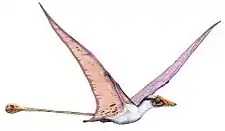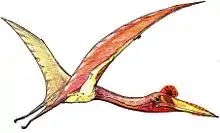Volgadraco
Volgadraco ("Volga River dragon") is a genus of pterodactyloid pterosaur from the Upper Cretaceous of European Russia. Volgadraco is originally classified as an azhdarchid, however, recent studies have concluded that it may belong to either the family Nyctosauridae,[2] or the family Pteranodontidae.[3] It is known from lower beak (holotype SGU, no. 46/104a) and postcranial fragments from the early Campanian-age Rybushka Formation of Saratov, Russia. The size of this animal, and the development of blood supply in the lower jaw are intermediate between older Santonian or Turonian azhdarchids like Azhdarcho and Bakonydraco and later Maastrichtian azhdarchids like Quetzalcoatlus. Volgadraco was described in 2008 by Averianov, Arkhangelsky, and Pervushov. The type species is V. bogolubovi, the specific name honouring Russian paleontologist Nikolai Nikolaevich Bogolubov. The authors consider the earlier named genus Bogolubovia to be a nomen dubium that in fact might be identical to Volgadraco.[1]
| Volgadraco | |
|---|---|
 | |
| Speculative reconstruction of Volgadraco as an azhdarchid | |
| Scientific classification | |
| Kingdom: | Animalia |
| Phylum: | Chordata |
| Order: | †Pterosauria |
| Suborder: | †Pterodactyloidea |
| Family: | †Pteranodontidae |
| Genus: | †Volgadraco Averianov et al., 2008[1] |
| Species: | †V. bogolubovi |
| Binomial name | |
| †Volgadraco bogolubovi Averianov et al., 2008[1] | |
References
- Averianov, A.O.; Arkhangelsky, M.S.; Pervushov, E.M. (October 2008). "A New Late Cretaceous Azhdarchid (Pterosauria, Azhdarchidae) from the Volga Region". Paleontological Journal. 42 (6): 634–642. doi:10.1134/S0031030108060099.
- Nicholas R. Longrich; David M. Martill; Brian Andres (2018). "Late Maastrichtian pterosaurs from North Africa and mass extinction of Pterosauria at the Cretaceous-Paleogene boundary". PLOS Biology. 16 (3): e2001663. doi:10.1371/journal.pbio.2001663. PMC 5849296 Freely accessible. PMID 29534059
- Averianov, A.O.; Arkhangelsky, M.S. (2020). "A large pteranodontid pterosaur from the Late Cretaceous of Eastern Europe". Geological Magazine: 1–13.













